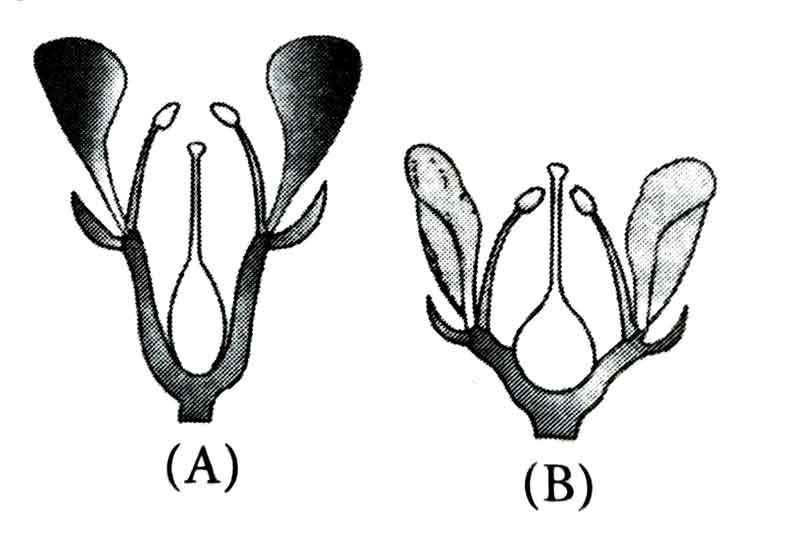Which of the following is an example of actinomorphic flower? [2024]
Datura
Cassia
Pisum
Sesbania
(1)
Datura is an example of actinomorphic flower, i.e., can be divided into two equal halves in any radial plane passing through the center. However, Cassia, Sesbania, and Pisum are zygomorphic flowers.
Match List I with List II. [2024]
| List I (Types of stamens) | List II (Example) |
| A. Monoadelphous | I. Citrus |
| B. Diadelphous | II. Pea |
| C. Polyadelphous | III. Lily |
| D. Epiphyllous | IV. China-rose |
Choose the correct answer from the options given below:
A-IV, B-II, C-I, D-III
A-IV, B-I, C-II, D-III
A-I, B-II, C-IV, D-III
A-III, B-I, C-IV, D-II
(1)
Monoadelphous - China rose
Diadelphous - Pea
Polyadelphous - Citrus
Epiphyllous - Lily
Identify the type of flowers based on the position of calyx, corolla, and androecium with respect to the ovary from the given figures (A) and (B). [2024]

(A) Epigynous; (B) Hypogynous
(A) Hypogynous; (B) Epigynous
(A) Perigynous; (B) Epigynous
(A) Perigynous; (B) Perigynous
(4)
Both given figures (A) and (B) represent perigynous flowers characterized by the position of gynoecium in the center and other floral parts on the rim of the thalamus almost at the same level. This is observed in plum, rose, and peach.
Match List I with List II. [2024]
| List I | List II |
| A. Rose | I. Twisted aestivation |
| B. Pea | II. Perigynous flower |
| C. Cotton | III. Drupe |
| D. Mango | IV. Marginal placentation |
Choose the correct answer from the options given below:
A-II, B-IV, C-I, D-III
A-I, B-II, C-III, D-IV
A-IV, B-III, C-II, D-I
A-II, B-III, C-IV, D-I
In Calotropis, aestivation is [2023]
valvate
vexillary
imbricate
twisted
(1)
In Calotropis, sepals or petals in a whorl just touch one another at the margin, without overlapping. This type of aestivation is called valvate.
In a pea flower, five petals are arranged in a specialised manner with one posterior, two lateral and two anterior. These are named as ______, ______, and ______ respectively. [2023]
Keel, Wings and Standard
Vexillum, Keel and Standard
Keel, Standard and Carina
Standard, Wings and Keel
(4)
In flowers of pea, there are five petals which are arranged in a specialised manner. The largest (standard) posterior petal overlaps the two lateral petals (wings), which in turn overlap the two smallest anterior petals (keel). This type of aestivation is known as vexillary or papilionaceous.
Match List I with List II. [2023]
| Type of flower | Example |
| (A) Zygomorphic | (I) Mustard |
| (B) Hypogynous | (II) Plum |
| (C) Perigynous | (III) Cassia |
| (D) Epigynous | (IV) Cucumber |
Select the correct option:
(A)-(I), (B)-(II), (C)-(IV), (D)-(III)
(A)-(I), (B)-(II), (C)-(III), (D)-(IV)
(A)-(IV), (B)-(I), (C)-(III), (D)-(II)
(A)-(III), (B)-(I), (C)-(II), (D)-(IV)
Axile placentation is observed in [2023]
tomato, Dianthus and pea
China rose, Petunia and lemon
mustard, cucumber and primrose
China rose, beans and lupin
(2)
When placenta is axial and the ovules are attached to it in a multilocular ovary, the placentation is said to be axile, as in China rose, tomato, Petunia, and lemon. Dianthus and Primrose have free central placentation. Pea, beans, and lupin have marginal placentation, while mustard and cucumber have parietal placentation.
The flowers are zygomorphic in [2022]
(A) Mustard
(B) Gulmohar
(C) Cassia
(D) Datura
(E) Chilly
Choose the correct answer from the options given below:
(A), (B), (C) only
(B), (C) only
(D), (E) only
(C), (D), (E) only
(2)
Zygomorphic flower can be divided into two similar halves only in one particular vertical plane, e.g., Gulmohar, Cassia. Flowers of mustard, Datura, and chilly are actinomorphic. Actinomorphic flowers can be divided into two equal radial halves in any radial plane passing through the centre.
Which one of the following plants shows vexillary aestivation and diadelphous stamens? [2022]
Colchicum autumnale
Pisum sativum
Allium cepa
Solanum nigrum
(2)
Colchicum autumnale, Allium cepa, and Solanum nigrum show valvate aestivation.